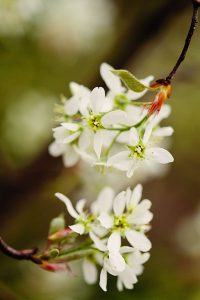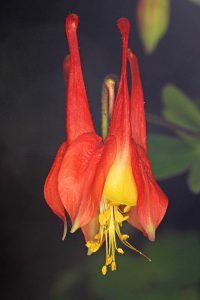Spring has come once more, and with it the possibility of growing a garden full of beautiful flowers. This year, why not consider planting your garden with flowers native to our region of Virginia? Native flowers can be maintained more easily than other kinds of flowers, provide food and habitat for native insects, and restore the environment. There are many important things to learn about which flowers you can plant and how you can rewild your garden. This guide provides links to sites and books in CRRL’s collection, and information on different species of native flowers. With it, you can learn how to create a great wildflower garden!
The Role of Native Flowers in Gardening
Native flowers are an important part of Virginia’s natural ecosystem and can make life much better for gardeners. Native flowers tend to be widely available, can often be more easily maintained than foreign flowers, and planting them can attract native birds and bees to your backyard. Central Rappahannock Regional Library has an excellent selection of books on flower planting to attract pollinators, with a special emphasis on honeybees. In addition to supporting pollinators, native flowers help the environment as they require less watering and other maintenance, such as mowing. Because they are naturally suited to our area, you won’t need to use nearly as many resources maintaining them. This will also save you money and time on maintenance. Finally, using native flowers also helps restore the environment from the effects of many invasive plant species that have become established in Virginia over the years.
Flowers are extremely important to pollinators, and pollinators are extremely important to us. Use these titles to start your own flower garden to help save the pollinators!
Flowers Around You: Native Flowers of Virginia
There are numerous beautiful and environmentally friendly native flowers you can grow in the Fredericksburg area. This online guide provides a good list of some of the native plants from the Rappahannock area. A particularly useful perennial is the eastern red columbine, a self-sowing perennial that provides nectar for bees and hummingbirds and has attractive red and yellow flowers. You can interplant it with other perennials, such as the Virginia bluebell, which typically attracts butterflies. Black-eyed susan is considered a perennial in our area, and its seeds are attractive to goldfinches and chickadees. If you live near a lake or other still body of water, you should consider growing lizard’s tail plants, which can provide a pleasant aroma and cover for fish and other aquatic animals.
In addition to these perennials, you may want to grow native vines in your backyard. Vines will require more micromanagement than perennials, and they can spread potentially to places you don’t want them! Virginia creeper is a particularly essential vine in our state, providing a vibrant color display in fall and cover for small animals. However, it can easily grow out of control, and its berries are toxic to humans, so it will have to be frequently cut back. You may also consider trumpet honeysuckle, which offers nectar for hummingbirds and fruit for quail, robins and finches. As useful as this vine is for hummingbird watchers, it can potentially grow two feet per week, so it must be cut back as well. Wild passion vine, or maypop, is known for its large purple flowers, which are a preferred nectar source by butterflies and bumblebees. It prefers a relatively dry soil.
Some of Virginia’s native trees and shrubs also offer beautiful flowers that are beneficial for native wildlife. Sweetbay magnolia has long been associated with Virginia’s lowlands and swamps, and its large white flowers have a strong vanilla scent. A wide variety of birds enjoy its berries. A shrub noted for particularly attractive flowers is wild azalea, which also is a preferred source of nectar for bumblebees. Another shrub particularly loved by bees is Carolina rose, the most disease-resistant rose plant commonly grown. The flowering dogwood is a tree noted for its four-petaled flowers, which are typically white, but can also be pink or sometimes red. The flowers serve as larval hosts for a wide range of caterpillars, and the tree can be easily grown and maintained in our area.
Some local organizations can help you choose which flowers to plant through instructional YouTube videos. CRRL has a longstanding partnership with the Master Gardeners of the Central Rappahannock Area, a program sponsored by the Virginia Cooperative Extension, whose outreach covers a wide range of agricultural topics, including gardening. Their useful videos include spring blooming wildflowers, zone 7 (the Fredericksburg area’s planting zone) gardening, and creating a native garden with shade plants. You may also find the videos from Master Gardeners of Northern Virginia useful. Some focus on invasive plants and native alternatives, preparing your garden for cicadas, and selecting native plants for a home garden.
Better Gardening Techniques and Rewilding
In addition to planting native plants, there are other techniques to learn that will help in rewilding the landscape and creating a more ideal backyard for nature. Rewilding is a philosophy of letting the natural world regain some control. Successful rewilding will be both better for the environment and reduce the stress of keeping a “perfect” garden. There are several basics to remember when rewilding your property. You should avoid using pesticides and collect rainwater falling from your roof to water your plants. Create as natural a landscape as possible by incorporating rock piles, logs and fallen trees (snags) and ponds. Learn which native plants are particularly useful for birds and pollinators. Build new soil for your flower garden using wood chips, fallen leaves, and mulch. And, remember, even though you are creating a natural landscape, you can still choose which plants to grow to make your garden easier to maintain.
CRRL has several books in its collection that provide helpful information on rewilding. Rewild Yourself explains how your rewilding efforts can benefit from a change in mindset. Edible Perennial Gardening, opens a new window teaches how you can grow perennial plants in a low-maintenance, small space. Natural Gardening for Birds demonstrates how you can select flowers and other plants based on their food value for bird species. And How to Make A Wildflower Meadow, opens a new window tells how to grow flowering meadows in a variety of landscapes. Use this information to create a beautiful garden and a more natural environment in your own backyard.



